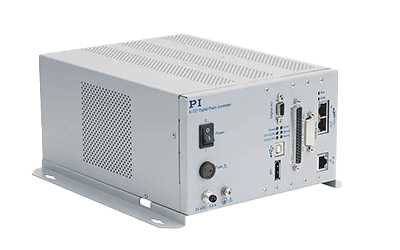What Is a Piezo Driver?

A piezo driver is a power supply and control device that stably operates and controls a piezo element.
A piezoelectric element is a device that converts mechanical displacement into a voltage value or an applied voltage into mechanical motion by utilizing the piezoelectric and inverse piezoelectric effects and is also called a piezoelectric element. Particularly in the case of conversion to mechanical operation, it is possible to control very small sub-micron levels at high speed.
Piezo drivers play the role of power source and control devices in controlling the precise motion of such piezoelectric devices.
Uses of Piezo Drivers
Piezo drivers are widely used in microscopes and machine tools for precision machining that require microscopic motion control. In optical microscope applications, piezo drivers can be used to drive X-Y stages and objective lenses to achieve accurate positioning at high speed.
For example, it is very suitable for high-speed three-dimensional imaging of dynamic phenomena in living cells. Piezo drivers are also often used in lathes and other machine tools for precision work that requires submicron-level accuracy.
To fully exploit the performance of actuator devices using piezo elements, the performance of the piezo drivers responsible for controlling their operation is critical.
Principle of Piezo Drivers
The principle of a piezo driver is that it has a power supply for driving the piezo element and a control circuit that accurately handles minute potentials (to take advantage of the piezoelectric and inverse piezoelectric effects). The piezo element itself has the characteristics of a capacitor, and the power supply side (piezo drivers side) that drives the capacitor as it charges and discharges must have the characteristics of an amplifier-type power supply that can draw in and discharge output current.
Piezo devices respond to minute voltage changes. If a voltage change in the circuit is detected in a steady state with no input, the piezo element will be driven even though no action is being taken, causing a malfunction.
The voltage supply for piezo drivers must be sufficiently stable. To ensure stability as a power supply, a shunt regulator or similar device is incorporated to monitor the voltage applied to the piezo element and constantly apply feedback.
By minimizing malfunctions and drift noise in this way, the driver can stably supply enough current to fill the capacitance of the piezo element and complete its drive in only a few microseconds in response to a sudden increase in the control voltage as input.
Other Information on Piezo Drivers
1. Piezo Drivers With PWM
Under the recent trend toward energy conservation as represented by the SDGs, audio amplifiers are utilizing PWM (Pulse Width Modulation) control to improve efficiency, and some manufacturers are also applying PWM control to piezo drivers.
Unlike dedicated audio amplifiers, the development of unique low-current, high-voltage PWM control-type amplifiers suitable for piezo elements has led to the commercialization of compact, high-efficiency piezo drivers.
2. Application to Earphones and Speakers
Piezoelectric elements themselves have been used in the acoustic field for some time, but their use has been limited to piezoelectric speakers and the like. In recent years, however, piezo drivers have been used in high-end earphones for high-resolution playback. When voltage is applied to piezo drivers, the piezo element generates pressure. Using this characteristic, when a music signal is applied to the piezo drivers as a voltage, the diaphragm vibrates accordingly. In other words, the voltage is converted into sound.
The advantage of using piezo drivers in earphones is that there is no signal conversion process, as is the case with dynamic-type earphones, in which a coil is used to convert the music signal into magnetic force to vibrate the diaphragm. In addition, since the piezo drivers vibrate the diaphragm directly, they operate at extremely high speeds, resulting in very high-frequency reproduction capability. This makes it ideal for reproducing the rich ultra-high frequency information of high-resolution sound sources.
However, to take advantage of the performance of piezo drivers, earphones with piezo drivers also use other high-end drivers for low and mid frequencies, and the products are expensive. The mechanism of piezo driver speakers is almost the same as that of piezo driver earphones. However, one manufacturer’s piezo speaker has a very thin and flexible structure that allows it to vibrate a variety of objects to produce sound.
They also have a wider sound range than previous piezoelectric speakers, especially enhanced output in the bass range, which has been a particular weakness of piezoelectric speakers. Recent LCD TVs have a very thin chassis, and existing speakers can no longer be installed. The above film-type thin piezo driver speaker is suitable for such thin TVs, and higher sound quality is expected in the future.